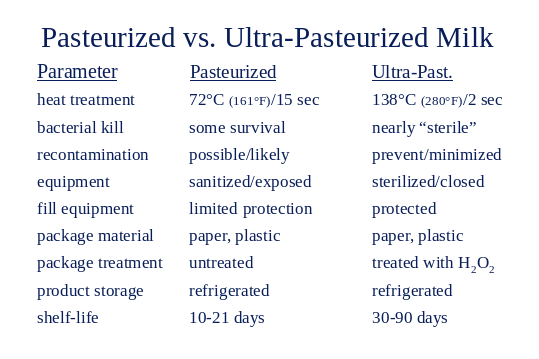CORNELL UNIVERSITY DEPARTMENT OF FOOD SCIENCE STOCKING HALL ITHACA
EDUCATION 998504 DMA MUSIC COMPOSITION CORNELL UNIVERSITY DISSERTATIONANALYSIS OF DIGITAL FORMATS (CORNELL TALK JULY 21 2004)
AOC GLOBAL HEALTH APPLICATION WEILL CORNELL MEDICAL COLLEGE
BIOGRAFIA RAMON MUNTANER TORRUELLA NEIX A CORNELLÀ DEL
ch 21 Cornell Notes Review in a Chemical Reaction
CORNELL DAIRY SCIENCE FACTS U N I V


Cornell University
Department of Food Science
Stocking Hall, Ithaca, NY 14853
Phone: 607-255-2893
Fax: 607-255-7619
Dairy Foods
Science Notes
Version 10-10-07
Pasteurized versus Ultra-Pasteurized Milk - Why Such Long Sell-By Dates?
Pasteurization and Ultra-Pasteurization are heat processes that are designed to kill bacteria (germs) in milk that may be harmful and/or may cause spoilage of milk products. These bacteria are sometimes found in raw milk from the farm, which is why drinking raw milk is not recommended. Milk from farms is transported to dairy processing plants and is generally heat processed within a few days after milking to prevent spoilage and to prolong its shelf-life. “Shelf-life” can be defined as the length of time that a food can be held under recommended or practical storage conditions and still maintain its “freshness” or acceptable quality. The anticipated shelf-life of milk is reflected in its “sell-by” or “code-date,” while many products remain fresh for a period after this date (2-5 days). Both Pasteurized and Ultra-Pasteurized milks should be held under refrigeration at all times. The major differences between Pasteurized and Ultra-Pasteurized milks are the intensity of the heat treatment and the method of packaging, both of which influence the anticipated shelf-life and sell-by dates.
Pasteurization: “Pasteurized” means that the milk has been heated to a minimum of 161°F for a minimum of 15 seconds or 145°F for 30 minutes (for equivalent kill of bacteria), and packaged under clean and sanitized conditions. Some bacteria survive pasteurization, most often in very low numbers, though they are not considered harmful and will generally not spoil milk under normal refrigerated holding conditions and times. Spoilage of pasteurized milk before its time is most often caused by bacteria that contaminate the milk after the pasteurization process and/or from improper refrigeration. Most dairy processors prevent this type of contamination, though it still occurs at times due to errors at the processing plant. Typical spoilage bacteria found in milk do not cause disease or illness, although the consumer will often find spoiled product to be offensive. A few types of bacteria are that survive pasteurization can eventually spoil milk, but this generally occurs later in shelf-life (past code). The shelf-life of pasteurized milk held under proper refrigeration, defined as less than 45°F, can range from 12 to 21 days post processing. Holding pasteurized milk at temperatures above 45°F will shorten the shelf-life dramatically; the colder the milk the longer it will last, the warmer the milk, the quicker it will spoil. Ideal storage temperatures for milk and dairy products are 34-38°F. Under ideal refrigeration, most pasteurized milk will remain fresh for 2-5 days after its sell-by date. Once opened, pasteurized milk should be used as soon as possible for best quality and taste.
Ultra-Pasteurized Milk: “Ultra-Pasteurized” means that the milk is heated to a minimum of 280°F for a minimum 2 seconds. This temperature and time combination is much more lethal to bacteria, killing virtually all of concern in milk. Ultra-pasteurized milk is also packaged under near sterile conditions, which makes recontamination with spoilage bacteria unlikely and rare. Though Ultra-Pasteurized milk is processed to be free of spoilage and harmful bacteria, it is not considered sterile because it is not hermetically sealed (i.e. canned), thus, it requires refrigeration. Ultra-Pasteurization is most often used for creams and specialty dairy products though its use for milk is becoming more popular. Ultra-Pasteurized milks will often have more of a “cooked” flavor when compared to conventionally pasteurized milks. The average shelf-life of Ultra-Pasteurized milk products is 30-90 days when held under refrigeration, but only until the product is opened. Once an Ultra-Pasteurized product is opened it may become contaminated with spoilage bacteria. Thus, after opening, Ultra-Pasteurized milk should be kept well refrigerated (34-38°F) and consumed within 7-10 days for best quality and taste.
|
|
|
|
|
|
Provided with support from the NY State Dairy Promotion Board; dairy farmers dedicated to the production, manufacture & distribution of quality dairy products.
CORNELL LECTURE NOTES ASSIGNMENT DATE WHAT ARE
CORNELL NOTE TAKING THIS METHOD OF NOTE TAKING IS
CORNELL NOTES SHEET NAME CLASS
Tags: cornell university, ithaca, science, department, stocking, university, cornell
- TEMELJEM ČLANKA 44 STATUTA OPĆINE KOTORIBA („SLUŽBENI GLASNIK MEĐIMURSKE
- COMISIA PENTRU EVALUAREA ŞI ASIGURAREA CALITĂŢII ŞCOALA GIMNAZIALĂ SLOBOZIA
- NEW JERSEY DEPARTMENT OF AGRICULTURE HSTRAIGHT CONNECTOR 1 YDROLOGIC
- INSTRUCTIONS FOR COMPLETING THE RECORD OF CONTACT INTERVIEW (TB41)
- EXPERIMENT NO 1 AIM TO DETERMINE THE THERMAL
- 01 DE ENERO DE 2007 DIARIO OFICIAL ACUERDO POR
- DIRECCIONES DE GMAIL DE WORDPRESS CURSO DISEÑO Y DESARROLLO
- INVITACIÓN PARA PRESENTAR PROPUESTAS COMPENSACIÓN DE LAS EMISIONES DE
- COMPARISON OF TRUE TYPE FONTS AND IFIMETRICS FIELDS
- VIAJE A ROMA 28 FEBRERO5 MARZO 2013 DÍA 1
- …………………………………… (DENUMIRE STRUCTURA ASOCIATIVĂ) NORME METODOLOGICE SPECIFICE PRIVIND EXERCITAREA
- YÖNETIM HIZMETLERI GENEL MÜDÜRLÜĞÜ YÖNETİM HİZMETLERİ GENEL MÜDÜRLÜĞÜ SINAV
- AFR 440052014 UNDER EMBARGO UNTIL MAY 13TH STOP TORTURE
- LEY 20091 LEY DE ENTIDADES DE SEGUROS Y SU
- FINANSIJSKI MENADŽMENT MR BISERKA KOMNENIĆ SPISAK TEMA ZA SEMINARSKE
- NORDISKA VÄGTEKNISKA FÖRBUNDET UTSKOTT 33 ASFALTBELÄGGNINGAR FORSKNINGSPROJEKT I
- 78 DERNGATE VOLUNTEERS 78 DERNGATE THE CHARLES RENNIE
- QUESTIONS AND ANSWERS ON PRIVACY AND CONFIDENTIALITY THE IFC
- INSTRUCTIONS FOR SFMA INTERFACE REQUEST FORM 1) ENTER AGENCY
- CONTRACT OF LEASE THIS CONTRACT OF LEASE IS MADE
- NAME DATE PERIOD HOMEWORK AND TEST
- CHAOTIC RANDOM NUMBER GENERATORS WITH RANDOM CYCLE LENGTHS
- ALBERTO VIDANO AKA “MERLINO” ALBERTO VIDANO NASCE A
- IPCCE3611 ANNEX III PAGE 3 IPCCE3611 ANNEX III AMENDMENTS
- CULTURA AUDIOVISUAL II “EL ECOSISTEMA PUBLICITARIO” 2º TRIMESTRE PRÁCTICA
- 11 JUDGES AND HUMAN RIGHTS ADDRESS BY JUSTICE CHRIS
- M MODALITÀ DI TRASMISSIONE RACCOMANDATA AR VIA GUAZZATORE 159
- ……………………………………………………… LİMİTED ŞİRKETİ GENEL KURUL KARARI KARAR NO
- 127 UPI ZAHTJEV POPUNITI ČITKO STRAIGHT CONNECTOR 2 CRNA
- NYMC IBC CONDITIONALLY APPROVED □ NOT APPROVED □ COMMITTEE
1 ZŁAMANIA W MIEJSCU TYPOWYM 2 MARTWICE JAŁOWE KOŚCI
KÉRELEM EUROPASS BIZONYÍTVÁNY KIEGÉSZÍTŐ VIZSGÁZÓ NEVE TELEFONSZÁM OKJ SZAKMA
VEJLEDNING INDEN DU GIVER ETF BESKED OM AT DU
RECURSOS LITERARIOS CON ESTA ACTIVIDAD LOGRARÁS RECONOCER LAS FIGURAS
 SUPPORTING INFORMATION FOR BODIPY BASED ADA MOLECULES EFFECT OF
SUPPORTING INFORMATION FOR BODIPY BASED ADA MOLECULES EFFECT OFRICHLAND COUNTY LOCATION REVIEWING ENTITY ADDRESS
UNITED MEMON JAMAT OF PAKISTAN ANNUAL GENERAL BODY MEETING
 1 SECURITY FEATURES 2 11 INTRODUCTION 2 12 GOALS
1 SECURITY FEATURES 2 11 INTRODUCTION 2 12 GOALS CICLO FORMATIVO DE GRADO MEDIO DE COCINA Y GASTRONOMÍA
CICLO FORMATIVO DE GRADO MEDIO DE COCINA Y GASTRONOMÍAANEXO IV MODELO DE DECLARACIÓN RESPONSABLE DE QUE LA
ISPRIČAO MI JE TADA JOŠ JEDNU PRIČU DA BI
MNB AZONOSÍTÓ R04 MÓDSZERTANI SEGÉDLET ÉRTÉKPAPÍR BEFEKTETÉSEK HAVI
CZĘSTOCHOWA 09072021 ZP261492021 ZBIORCZE ZESTAWIENIE OFERT DOSTAWA MEBLI BIUROWYCH
BANKKÁRTYASZERZŐDÉS – PÉNZHELYETTESÍTŐ ESZKÖZÖK 1 TÖBBOLDALÚ JOGÜGYLET AZ
 YOU MUST USE THIS FORM TO RECORD YOUR REFLECTIVE
YOU MUST USE THIS FORM TO RECORD YOUR REFLECTIVEPATRYK HAJDO SPECJALISTYCZNA PORADNIA PROFILAKTYCZNO – TERAPEUTYCZNA UL SZUJSKIEGO
 OBČINA ŽELEZNIKI OBČINA ŽELEZNIKI ČEŠNJICA 48 4228 ŽELEZNIKI DOKUMENT
OBČINA ŽELEZNIKI OBČINA ŽELEZNIKI ČEŠNJICA 48 4228 ŽELEZNIKI DOKUMENT FOREIGN SERVICE ASSIGNMENT SYSTEM CIVIL SERVICE MINIMUM QUALIFICATIONS &
FOREIGN SERVICE ASSIGNMENT SYSTEM CIVIL SERVICE MINIMUM QUALIFICATIONS & WALES TOWN BOARD MEETING 2020 11 OCTOBER
WALES TOWN BOARD MEETING 2020 11 OCTOBERSTATUTORY CHANGES FOCUS GROUP JULY 15 1997 THE GEORGIA

